
The ever increasing demand for efficient, convenient, and cost-effective ways to grow food in the modern world has unfortunately led to unethical food production methods that come at the expense of the environment, animal welfare, and human health. These methods are mainstream, and the meat industry specifically perpetuates the cycle of raising animals using inhumane methods. This means that the meat they produce has higher instances of bad fats since these animals are not fed a diet that is good for them–all for the sake of maintaining inexpensive production costs.
These conditions found in the factories used to produce meat are causing a lot of people to switch over from standard grocery meat options to brands that have a higher standard of production, who label their products with terms like "humanely raised," "grass fed," "free range" and "antibiotic free”. These words can often be misleading, but all in all, they are definitely considered progress in the food industry that really needs further improvement.
What is the Best Food for my Pets?

Now, there is a demand for more sustainable and ethical agricultural and pet food products. By purchasing these, you can contribute to the promotion of the humane treatment of livestock. There is a selection of commercially marketed choices already available in the ever growing market:
- Organic
- Hormone, Steroid, and GMO-free
- Grass-fed
- Vegetarian-fed
- Cage Free
- Free-roaming/free-range
Why Should You Choose Higher Quality Foods for Pets?
Though it may be more expensive to purchase free-range produced foods, supporting ethical food production poses major benefits. By buying these brands, you are putting in your monetary vote for better standards in the food industry–even if this will result in only a small improvement such as removing battery cages. Supporting these efforts will help open up the market for other similar products to be produced in the future, and they might even become more affordable as well.
What about Feeding Pets a Raw Food Diet?
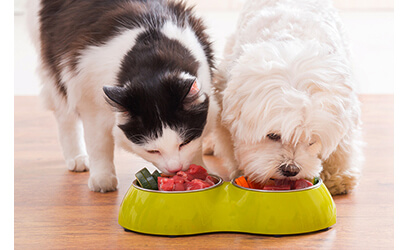
Raw meat like turkey, chicken, fish, bison, rabbit, and venison are often purchased for people’s pets at farmers markets and sometimes even ordered online. A few websites that sell meat for people’s consumption may also offer selections to be used for pet food. One advantage that raw diets have is that you are aware of exactly what is being eaten by your pets, along with knowing its precise source; however, it begs the question: Is this the healthiest, most evidence-based option?
To be frank, the raw food model is based on the falsehood that nature provides animals with the most nutrition, citing the belief that this is what they would eat in the wild. For instance, wolves who eat raw diets live half as long as domesticated dogs who are getting their nutrients from the proper dog foods.
Animals that Aren’t Farmed in a Factory
The animals listed below are not factory raised with battery farming methods, meaning that any pet food that you purchase that only has the following meat will be more ethical:
- Bison
- Sheep
- Quail
- Brushtail
- Elk
- Deer (venison)
Raw Meat and Frozen Prepared Meals
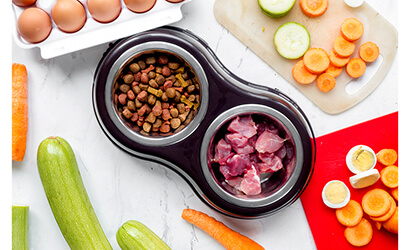
A lot of meat dealers that sell meat to humans will often offer pieces for your pets. If you want to make a homemade raw diet plan for your pet, it is necessary that you consult with a nutritionist first. If you decide that a whole meat diet is a path you want to take, see the list below to learn about animals that have been properly raised, both for your pet’s benefit as well as your own:
U.S. Wellness Meats
This is a meat dealer that specializes in humanely raised animals that live on a farm and forage. The cows on these farms are fed grass exclusively during their entire lives. The website for this company has a section dedicated to pets, but really, any of the meat on the list will make acceptable food choices for cats and dogs alike so long as bones aren’t included. They also offer bones, ground beef, and organ meat which is not recommended.
Hearst Ranch – Hearst Ranch Pet Food
This brand offers pasture raised, grass fed meats along with its selection of food for human beings. The animals are allowed to roam freely and allowed to naturally forage.
9 Natural Frozen Raw Nibblets Dog Food
This meat comes from ranch raised, grass-fed animals from New Zealand and contains no starches or grains. While it has a low protein content, it comes with only the highest quality meat and vegetables which does include organ meat. The food also comes with various other ingredients like mussels, which are reported to give pets a natural source of glucosamine, great for aging pets. Frozen food can be ordered in specialty pet shops or online.
Rad Cat Raw Diet
This site claims to use high quality organ and muscle meats for their natural food and treat selection. Their meats come from the United States and have been inspected by the USDA. They are free range, pasture raised, and free from antibiotics and hormones. These organ and muscle meats are partially ground and frozen to ensure that the quality remains.
The Raw Advantage
The meat from this company is known for its quality and it comes from a variety of places, all of which are detailed on their website. The food is ground up raw meat that can be purchased in chub or chunk forms.
Dehydrated or Freeze-Dried Food
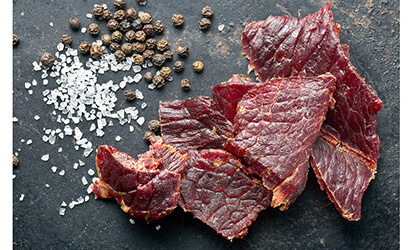
Freeze-dried food is said to be some of the healthiest processed food options besides raw meat. There are a number of brands that contain free-range meat along with other healthy ingredients. These can be found below.
The Honest Kitchen
This brand offers both cat and dog food options that contain free range, human grade USDA certified chicken. Petaluma Poultry is the supplier for The Honest Kitchen’s chicken, which has been given a high Whole Foods Gap rating referencing humanely raised meat. Both of these options are grain free, but they do contain sweet potatoes. This food has a similar consistency to dry dirt which requires you adding a bit of water to it. The food makes a great additive to raw food or pelleted diets. There are other freeze-dried food choices here, including fish, beef, turkey, and chicken.
Addiction Pet Foods (Brushtail)
This brand offers a dehydrated, raw option of wild caught brushtail. The website states that it is an environmentally friendly choice that is also a great option for pets who have allergies.
Dry Food
Blue Buffalo Adult Free Range Lamb & Brown Rice
This brand has free range lamb from New Zealand and is antibiotic, hormone, and steroid-free. In New Zealand, lamb is known to be raised with excellent standards but the food is not free from grain. Blue Buffalo food can be found in pet store chains.
Addition Dry Pet Foods
Meat for this food comes from healthy animals like venison, lamb, salmon, brushtail, and even kangaroo, which is rich in linoleic acid. This food comes without grain and features potatoes, oats, and supplemental additives. This brand is great for cats and dogs who have allergies to certain meat.
Wysong‘s Nurture with Free Range Pheasant
Recommended for both cats and dogs, this is a pelleted food that contains shreds of cold-processed, essentially raw free-range pheasant. High in protein, this food also boasts meat as its first four ingredients. This food also contains chicken that isn’t free-range. This company acknowledges that dry food is not perfect for pets, but it does do its best to bring the best nutrition in the form of kibble and has implemented techniques for processing that hold onto the foods’ nutritional values. It isn’t very common in popular chains, but this brand can be purchased in bulk online or in specialized stores.
Orijen and Acana
This brand is a leader in meat that is wild caught or free range. It also features other nutritious plant-based ingredients that feature very little potato content and no grains at all. The ingredients vary, each of them containing high sources of protein. Take caution as there have been reports that the food is too rich, resulting in symptoms such as diarrhea. You could always dilute the food with other brands.
Open Farm is ‘Certified Humane’
This is a brand that puts emphasis on the humane treatment of their animals. It is hard for a pet food brand to get the certified humane label. The food brand removes any cages, stalls, and crates, and provides clean resting areas. It is made from 100 percent certified humane meat and contains wild-caught fish. It also features non-GMO vegetables and fruit. It comes with high recommendations by Dog Food Advisor.
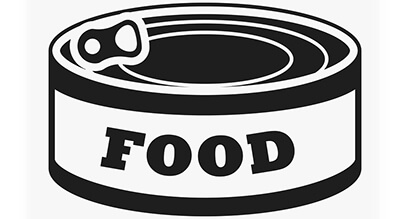
Canned Food
You can consider adding different canned foods to your pet’s diet if you are only giving them dry food at present. This will give them more moisture that they need. Canned food does commonly have low protein and should not make up most of your pet’s diet.
Newman’s Own Organics
(Canned Organic Beef Formula)
This brand takes advantage of free-range beef that is grass fed. The animals can roam in an area the size of two soccer fields. They are USDA organic, and the food does not contain brown rice, soy, or barley.
Treats
Only Natural Pet All Meat Bites
This online site sells meat cuts that are made up of free-range chicken freeze-dried treats. They also feature free-range grass-fed bison and free-range kobe beef. This site also boasts "Bully Sticks," which come from Brazilian cattle that have been grass fed. There are also smaller brands that produce raw diets and can be found in your town or online. Try these selections and also go to your local farmer’s market and for other alternatives to pet food and treats.
In-Depth of Pet Food Explained
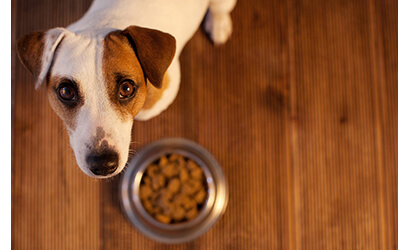
There isn’t much that a person wouldn’t do to keep their pet healthy and happy. In the United States, over 95 percent of pet parents consider their pets to be a part of their family. This growing trend goes hand-in-hand with the trend of healthier pet foods and treats becoming more popular. Pet owners have also been gravitating to foods that are more similar to human food or food that addresses the same health concerns that we take into consideration when we grocery shop. This includes genetically modified ingredients and unnatural preservatives alike.
At least 55 percent of Americans said that even if they were on a limited budget, they’d be willing to give up treats like chocolate so that their pet could enjoy a higher quality of food. Furthermore, 43 percent of pet owners in America said they’d trade their Netflix subscription for the same thing. People are definitely interested in finding these healthier options, but are pet food brands ready to satisfy this demand?
Source
Basic Annual Expenses for Pet Owners
When considering pet food and other factors, pet owners should also be taking into consideration the rest of the expenses that come with owning a pet. The list below shows a dollar amount that is based on their spending in the last 12 months before the report. Reports by the 2017-2018 APPA National Pet Owners Survey state the following cat and dog pet expenses as being typical and rather average:
| Product/Service | Cost for Dogs | Cost for Cats |
|---|---|---|
| Surgical Vet Visits | $474 | $245 |
| Routine Vet Visits | $257 | $182 |
| Treats | $72 | $56 |
| Food | $235 | $235 |
| Grooming | $84 | $30 |
| Boarding in Kennels | $322 | $164 |
| Toys | $47 | $30 |
With the trend of dog owners continuing to humanize their pet foods, premium food is likely to drive the cost per year up even further. Grain free and high-protein dog foods will keep this growth going, along with dehydrated raw food and freeze dried food options. Consumers prefer minimally processed food which will also help sales of dog food with natural formulations increase in the coming years.
What Is Really in Pet Food?

While the imagery on bags and cans of pet food might make one think that their food is being prepared by chefs using gourmet ingredients, this is rarely true. When animals are slaughtered for the production of food, the healthier, lean muscle is cut away for consumption by humans. The remnants of the carcass, including organs, bones, beaks and blood, is what ends up in your pet’s food. This is commonly labeled as by-products or "meal."
Alongside the carcass parts detailed above, there are other leftovers that come from the human food world, including out of date meat, restaurant grease and more. It will also usually come from livestock animals that are disabled, diseased, dying, or dead. This comes into play through a process known as rendering.
Rendering is industrially processing waste animal tissue to transform it into usable ingredients by melting it. This means placing the carcasses of livestock and other leftovers into massive vats and grinding it up to cook it for a number of hours. This removes water, separates fats and kills parasites, viruses, and bacteria. The resulting fat goes into pet food. The remaining proteins that are dry solids become the meal or by-products. By-products often consist of spleens, lungs, brains, bones, fatty tissues, kidneys, intestines, and stomachs.
Source
All of these rendered products are considered unfit to be eaten by humans, which poses worries for many pet owners. Rendered products often have high protein levels, but the quality of said proteins is often under question. These inferior sources of protein are not tasty for pets and are often sprayed with fats or artificial flavorings in order to make them more palatable.
Interpreting Label Claims
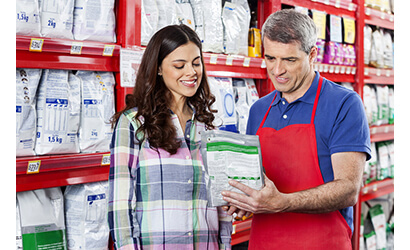
With all of these factors, how can one determine which food is truly high quality? Pet foods often mislead buyers by labeling them as premium or gourmet. What does this mean, and is it truly worth the extra cost? The labeling is mostly just a ploy, as these sorts of labels are not required to contain higher quality ingredients than any other pet food.
Those labeled natural also do not fall under the quality standards of the organization that oversees and regulates pet food manufacturing, the Association of American Feed Control Officials (AAFCO). The AAFCO says that natural pet food needs to have ingredients that only come from mined, animal, or plant sources and nothing else. These foods can’t be processed highly or contain chemical or synthetic ingredients like coloring, preservatives, or artificial flavors. That said, contrary to popular belief, natural does not mean organic. Many natural ingredients can be taken out with chemical processes and are therefore not organic. Whole foods are not always natural either.
Organic pet foods are made without the use of artificial fertilizers or pesticides and are free of both industrial and human waste contamination. Organic food must also be free of genetically modified organisms, sewage sludge, or ionizing radiation. If animals are involved in the production of the food, they have to be raised without growth hormones or antibiotics as well as being fed a healthy diet. Those making this type of food have to have a special certification while following production standards that are specific to the act of labeling a product organic.
Furthermore, before a product can have the organic label, a government-approved company comes to certify and inspect the location in which the food is grown to ensure that all rules are being followed to meet the standards of USDA organic food.
Source
How Do I Know if a Food Is Organic?
The USDA puts in place three different labeling categories for organic products:
- Organic: Made with a minimum of 95 percent organic ingredients
- 100% Organic: Made with 100 percent organic ingredients
- Made with Organic Ingredients: These products must have a minimum of 70 percent organic ingredients and have strict restrictions placed on the remaining 30 percent of the material. This includes no genetically modified organisms.
What is GMO?
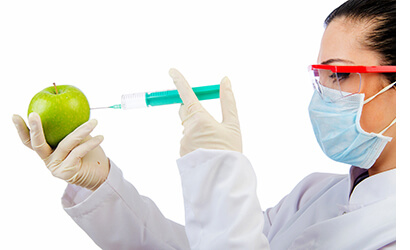
We’ve used the words GMO, or genetically modified organism a lot, so let’s take a look at what that really means. A genetically modified organism is an animal, plant, or other organism whose genetic composition has been altered or modified by combining different DNA, also known as gene splicing. This also includes transgenic and gene modification technology. This is a young science that creates a lot of unstableness in animals, plants, viral, and bacterial genes which do not occur naturally.
Genetic modification is pretty much part of everything humans eat every day, but there are anti-genetically modified organism organizations that keep up with non-GMO verification. For a product to be non-GMO verified, the ingredients have to be evaluated for compliance with their standards. There are three risk levels.
– High risk. This means that the ingredient is taken from or contains compounds that have been genetically modified. These include things like corn, canola, alfalfa, cotton, soy, animal products, papaya, sugar, and more.
– Low risk. The ingredients do not contain compounds that involved with organisms known to be genetically modified. This includes spinach, tomatoes, lentils, avocados, and sesame seeds.
– Non-risk. These ingredients are not from biological organisms and are therefore not able to be genetically modified.
What Does the USDA Organic Seal Mean?
This seal assures customers about the integrity and quality of their organic products. Those that are certified organic must have records that indicate their compliance with the system. These facilities are annually inspected along with the random checks that they undergo.
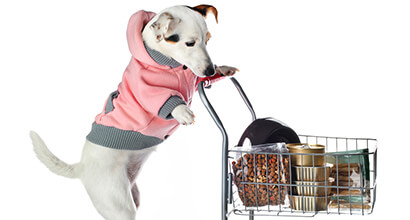
Why Does Organic Food Cost More?
Organic food doesn’t always cost more. For instance, cereal, coffee, bread, and hamburger meat may cost the same amount or less than conventionally produced items. As the demand for organic food grows, the costs will keep coming down. That said, when you notice a higher price, consider the following:
- Organic farms are often smaller than typical farms and don’t get the same economic benefits
- The price of conventionally grown food doesn’t include the cost of the cleanup that tax dollars pay for
- Organic farmers don’t get subsidies from the government like a conventional farmer does
- Farming organically is more labor intensive
Organic Food and Nutrition?
Does Organic Food Have More Nutritional Value Than Conventionally Grown Food?
Currently, there is no official research that can decide this. It is hard to conduct studies that control the many variables that could affect nutritional value, like soil type, seeds, post-harvest handling, and variety of crops. That said, some recent studies in journals that have been peer-reviewed say that organic foods can have higher nutritional value.
What Is Artificial Food?

The phrase artificial usually speaks to ingredients that have been created in order to imitate natural food, like different flavors or colors. Sometimes, these artificial ingredients are added to give a food a nutrient like calcium when it is added to orange juice. When it comes to a nutritional label, though, artificial means anything that has been added to a food which is not taken from a whole food. Labels list all of the artificial compounds; if a food sounds like it came from a lab, it is likely that it did.
Manufacturers of food use both artificial and natural ingredients that will preserve or add to the flavor, texture, and color of food. Both of these compounds fortify those processed ingredients and give them additional minerals or vitamins. Some ingredients that can be found naturally may also be manufactured and made to be more economical than natural alternatives. For instance, one could find vitamin C naturally in an orange, or it could be produced in a lab.
Source
Pet food is made especially for domesticated animals with a formula for their specific nutritional needs. Pet food will often consist of vitamins, minerals, meat by-products, meat, grain, and other ingredients. About 300 manufacturers in the United States produce well over 7 million tons of pet food annually and make up one of the largest categories in packaged food. Pet owners have a choice of over 3,000 foods, including canned, dry, and semi-moist varieties.
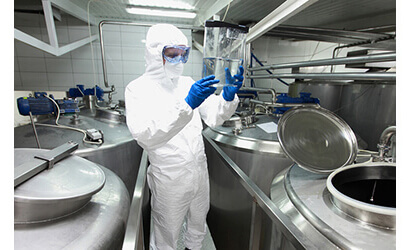
Pet food that is produced commercially began as dry, biscuit-type dog food that was made in 1860 in England. Not long after, manufacturers began coming up with more sophisticated formulas. These included nutrients that were considered crucial for dogs during that time. At the start of the 20th century, these prepackaged foods were also available in the United States. They often were made up of dry cereal, but after World War I, dog food was often made out of canned horsemeat. In the 1930s, dry meat meal dog food and canned cat food became available. In the 1960s, dry cat food, semi-moist pet food, and dry dog food were innovated.
During the 1980s, pet food trends began to include a higher demand for dry dog and cat food and less for the canned varieties. Research showed that a soft diet of canned food could lead to gum disease more swiftly than dry dog food could. Generally speaking, the public became more health conscious, which led to more interest in scientific formulas for pet foods that were more nutritious. This included variations of life cycle products for young and old animals along with foods that were therapeutic for certain health conditions like urinary problems and weight loss.
Pet food manufacturers also tended to use less tallow and fatty tissue and veered more toward tissue rich in protein. Lastly, the pet treat industry grew with products offered like sausage-shaped treats, jerky snacks, biscuits, and biscuit pieces that were known as kibble.
Raw Materials
The main ingredients in pet food are meat byproducts from poultry and seafood, and also soybean and feed grains. The animals that are often used in rendering include livestock, horses, and animals that have been euthanized. An estimated 5 million pets, according to the National Animal Control Association, have been shipped off to plants in order to be rendered for pet food during the 1990s. These are often listed as bone or meat meal on the list of ingredients.
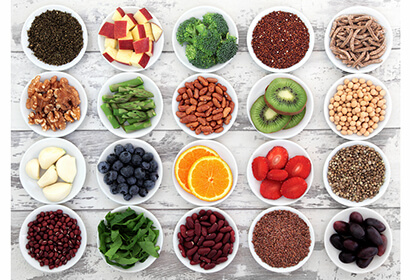
The animal parts used in pet food can include carcass parts like cheek meat, bones, and organs. Organs include lungs, livers, udders, spleens, kidneys, intestines, and the tissue from the stomach. Cereal grains like cornmeal, barley, soybean, and cracked wheat are commonly used to improve the consistency of the product as well as reducing the cost of raw materials. Liquid ingredients are often blood, meat broth, and water. Salt, stabilizers, preservatives, and gels are usually a necessity. These gels allow for homogeneity during the manufacturing process and serve to provide moisture control. These include bean gum, carrageenan, cellulose, and other thickeners and starches. The taste can be improved using protein, sweeteners, yeast, fat, fish solubles, and concentrated flavors. Usually, artificial flavors aren’t used, but bacon or smoke flavors can be added to pet treats. A lot of these manufacturers will supplement food and treats with minerals and vitamins that are often lost in processing.
Ingredients often vary depending on the type of food for pets being made. The difference between dry and canned pet food lies in its moisture content. Canned food often contains around 70 to 80 percent moisture because these are typically made from fresh meat. On the other hand, dry pet food has no more than 10 percent moisture. Other ingredients that are used in dry dog food include animal fats, bone, and meat meal, oils, and corn gluten feed. For a meaty texture, manufacturers will often use starch ingredients or ingredients such as albumins, collagens, and casein along with plasticizing components. Semi-moist pet foods need binders which can come from a number of sources. These can include cereal flours, low alkyline mercaptans, gels, sulfides and disulfides, thiamin, and salt. These semi-moist foods may also include bran flakes, emulsifiers, dried skim milk, soybean flakes, soluble carbohydrates, and dried whey.
Antioxidants can often be found to slow down oxidation and fat rancidity. These include butylated hydroxy toluene (BHT), butylated hydroxy anisole (BHA), and tocopherol. To stop the growth of bacteria and mold, manufacturers will also use sorbic acid, propylene glycol, sucrose, or calcium and potassium sorbates.
The Manufacturing Process

The general manufacturing process for food for pets is not unlike that for processed human food. The fleshy products that are utilized in pet food have to first be processed, or rendered, in order to separate the fat, water, and protein components like viscera, hooves, and bones. Mostly, meal is rendered by third party companies and then shipped to the manufacturing company. The meat meant for canned food has to be delivered fresh within a three day period, while frozen meat can wait and be used for dry food.
Manufacturing your pet’s food is a long process that must be undertaken under specific regulations that follow specific recipes. In order to process the food, rendering must occur. Rendering simply means the process of grinding and cooking up the flesh byproducts and the flesh itself. Then, the meat will be combined with other ingredients and shaped into the appropriate forms according to the recipies. The shapes, sizes, and other forms are often designated by different pet food brands and can come in a wide variety of styles. The finished food product is then put into their designated, pre-printed containers and then sent off to distributors to send out to retail chains and other suppliers.
Changes are always being made in pet food packaging and processing to produce better quality products with a longer shelf life. For example, canned dog food is vacuumed sealed and can last anywhere between three to five years with little reduction in its nutritional value. Dry dog food has a short shelf life between 10 to 12 months and needs preservatives in order to retain freshness. These preservatives aren’t always unnatural and to be feared. Vitamins C and E are often used for this purpose.
How Pet Food Is Made
Here is a step by step break down of the pet food manufacturing process.
- The rendering process is typically done by different mechanical meat processors. This process consists of breaking open different fat cells, and this can be done either by solvent extraction, enzymatic extraction, or heat. The residue is then dried.
- The meat products being used are ground coarsely in order to reach the proper texture.
- To help with processing the meat further, the ground meat is then cooked continuously. The cooking process uses live steam that is kept at the optimal and appropriate temperature.
- The flesh products of the meat are ground again after they have been cooked initially. This is to produce a consistency that is more uniform. In terms of chunky or semi-moist food, these batches are cooked unevenly on purpose in order to create the perfect food texture that is chunky and thick.
- The resulting meat mixture is then blended and combined with a variety of other ingredients. These can include things like vitamins, minerals, and cereal grains.
- Semi-moist and dry food is usually heated after this so that it will thicken up the starch. To give the food the authentic marbling of real meat, the mixture can often be unevenly cooked with half of the batch colored white and the other colored red. Semi-moist foods have to be stabilized in order to keep the proper amount of moisture in the semi-moist and dry parts of food.
- Dry and semi-moist food may have to be extruded under high pressure with a device that has holes in its plates. The holes serve to shape the meat and size it into specific types for different products. This can include kibbles, biscuits, meatballs, slices, pellets, or patties. An alternative to this is to use gelatin to expand the combination of ingredients. For meat that is marbled, the mixture of white and red meat is combined and broken off into chunky bits.
- Products are measured out and put into their appropriate containers. Moist canned foods will be sealed with a vacuum to keep out as much oxygen as possible to prevent the fat in the food from spoiling. Dry pet food will be poured into containers that have already been printed.
- Pet food cans are then sterilized by putting them through a heating chamber known as a retort. This retort can either be a hydrostatic, continuous type, or done in batches. These cans reach around 250 degrees Fahrenheit and are heated for 80 minutes. Cooking times and temperatures can depend on steam pressure, contents, and can sizes.
- The cans are cooled quickly to a temperature around 100 degrees Fahrenheit. Then, the cans are dried off and given a label.
- The containers are put into their packages which then go into corrugated boxes. They can also be shrink wrapped and placed onto trays also made of cardboard. Once this occurs, the pet food is prepared to be shipped to its distributors!
Quality Control

Manufacturers of pet food have to conform to different rules and regulations that are set by a number of different federal and state agencies. This includes the FDA, or the Food and Drug Administration, the USDA, or the United States Department of Agriculture, and the FTC, or the Federal Trade Commission. The USDA is responsible for controlling the quality of the meat and will decide which animals are able to be used in different pet food. The FDA is in charge of regulating the ingredients, and they do this by setting both minimum and maximum limits on different nutrients. They also ban the use of antibiotics in pet food, since pet food can get ingested by children. The AAFCO, or the Association of American Feed Control Officials, is a non-governmental advisory group that has different representatives in every state and is tasked with registering the 3,000 varieties of pet food.
On pet food labels, there is a "guaranteed analysis" statement that can be found. It was created almost one hundred years ago when food manufacturers were using ingredients that were undesirable, such as limestone or sand, to add weight to their products. This guaranteed analysis makes sure that only minimum percentages of crude fat and crude protein along with maximum percentages of moisture and crude fiber are used. Other guarantees may include the minimum amount of sodium, phosphorous, calcium, and linoleic acid in dog food. It also controls the amount of taurine, ash, and magnesium in food for cats. The maximum amount of moisture allowed in canned food is 78 percent; for dry food, the moisture content can only go as high as 12 percent.
Labeling pet foods the proper way is required in order to give the buyer accurate information. There are guidelines that have been set by both the AAFCO and the FDA’s Center for Veterinary Medicine. There are six basic elements that need to be on the label. These include the net weight, product name, ingredient list, guaranteed analysis, name and address of the distributor or manufacturer, and nutritional information. The product name also needs to accurately define the contents while sticking to the percentage rules.
The 95 percent rule means that if a product name says that it has poultry, meat, or fish as its main ingredient, it has to have at least 95 percent or more of that particular ingredient. This percentage does not include water used during the manufacturing process. If there are two meat ingredients listed as the main ingredients, the combination of the two must equal out to be 95 percent or more.
The 35 percent rule applies to foods labeled with words like "meat entree" or "chicken dinner," along with terms such as nuggets, formula, platter, and more. This requires that the listed food has to make up a percentage of between 25 and 95 percent of the ingredients measured in weight. If there are more than two ingredients listed in the name, these ingredients have to be at least 3 percent in weight. The main ingredient has to be listed first. The other ingredients must be listed on the label in order by weight.
Another rule, often called the "with" rule or the "3 percent rule," is meant for minor ingredients that are detailed on the label. If a product says "with cheese," for instance, the product must contain a minimum of three percent cheese. Lastly, the flavor rule says that if a flavor component like meat is put into the product name, it has to be detectable.
The word flavor must be in the same size and the same font style as the corresponding ingredient in order to prevent misleading their customers. Any photos or art on the label cannot be intended to mislead the customer, either. All of the ingredients have to match up with the names that are listed on the AAFCO’s Official Publication. Any colors, stabilizers, flavorings, or preservatives must adhere to the "Generally Recognized as Safe," or GRAS, rule. The term natural cannot be applied to those pet foods that contain preservatives, colors, or artificial flavorings.
The calorie amount per container and per serving also need to be listed in the same way that human food is labeled. Package codes have to be printed on every container. The other associations that monitor pet food include the American Veterinary Medical Association (AVMA), the American Animal Hospital Association (AAHA), along with the Pet Food Institute (PFI).
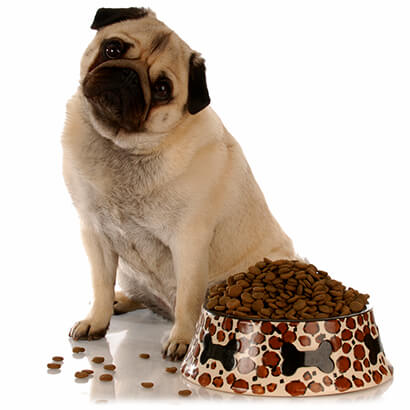
Regulation of Pet Food
Pet food products are some of the most regulated food products that can be found in a grocery store. State and federal laws and their regulations are meant for different aspects of pet food. This includes labeling, manufacturing processes, and the ingredients themselves. Essentially all pet food regulations and laws in a state are governed by the AAFCO. Members of the AAFCO work together in order to create and develop ingredient definitions, labeling guidelines, nutritional requirements, and regulations and laws surrounding the pet food and animal feed sector. The work that AAFCO does helps promote regulations and laws that are uniform from one state to the next. This will ensure that a consumer has protection nationwide along with the promotion of interstate commerce.
Federally speaking, pet food is regulated by the Federal Trade Commission, the United States Department of Agriculture, and the United States Food and Drug Administration. The FTC and the FDA both have the main authority when it comes to advertising claims and labeling. Alongside the state regulations, the FDA regulates the finished pet food product and its ingredients. The FDA also has certain requirements that pertain to any and all pet food, including:
- Products have to be free of harmful compounds and substances
- Products have to be wholesome and pure
- The label of the product must be truthful
- Canned products have to meet the same low-acid regulations for canning that apply to those canned foods made for humans
Every plant that makes pet food is subject to inspections by state and FDA regulators. Furthermore, state control officials along with the FDA can test pet food ingredients along with their finished products whenever they please in order to ensure and confirm that they are meeting the guaranteed nutritional content included on the label. They also serve to verify that they are also free of substances considered undesirable.
State regulators have the authority to halt the sale of a product to consumers should they find a good cause, like the failure to meet the nutritional guarantee or due to false claims with the labeling. The FDA has the authority to issue warnings as well to consumers who buy the pet food brands. This is secured under the state animal feed regulations and laws. Pet food labels are required to give non-misleading, totally truthful information along with:
- Displaying the name of the manufacturer and the quantity statement
- Identifying the product as a cat or dog food in a clear way
- Giving the guaranteed chemical analysis that is in adherence with the state animal feed regulations and laws
- Displaying the right brand name that will not be construed incorrectly regarding nutritional information
- Listing ingredients that are in adherence to definitions set by the AAFCO
- Ingredients must be listed by their weight in descending order
Pet food brands may not imply or express any claim that states a product is scientific, perfect, complete, or balanced due to AAFCO. This would be misleading to the customer and based on no scientific ground. That said, there are exceptions to the rule. The exceptions are as follows:
- The claim has been modified to state that it is balanced or complete for specific stages of life
- The food is nutritionally adequate for a normal adult pet during all of its life stages
Pet food manufacturers and producers are also required to list on their unique product labels the AAFCO ingredient name. This means that there is a consistent ingredient list across the country to ensure quality. In most cases, this extends around the globe as well. Because of the AAFCO’s process of defining ingredients, the pet food ingredient list will always list names of the different components such as poultry by-products, wheat gluten, and sodium selenite.

Pet food ingredients, even those with unfamiliar and strange names, all have at least one purpose or function in the product. It doesn’t matter whether it adds nutrients, keeps the food in its desired shape, provides the food with the correct texture, preserves its freshness, or does anything else. Some of these ingredients can also serve a wide variety of purposes as well.
An example of this is the relatively inexpensive ingredient called wheat gluten. Wheat gluten serves as a binding agent in pet food, just like the bread crumbs keep together a meatloaf. Without binding agents like wheat gluten, canned products that have things like chunks, slices, or flakes will not hold their shape and will instead become a sloppy mess. Wheat gluten also serves to provide benefits such as being a source of high quality, easily digestible protein.
A lot of the time, the ingredients that have the strangest names that are reminiscent of chemicals will be good for a pet. They will serve to provide essential amino acids, minerals, and vitamins to your pet’s food. Many of these amino acids, minerals, and vitamins are hard for your pet’s body to digest on its own while in its pure state. To help this digestion process along, pet food manufacturers will include these compounds in their food. Some of these essential nutrients, such as potassium, for instance, can even be fatal when consumed in their pure forms.
To give you a better understanding of some of these pet food ingredients that you might be concerned about, we have compiled a list below:
- Sodium selenite. This is the nutrient selenium.
- Biotin. Biotin is another term for Vitamin B7.
- Pyridoxine hydrochloride. This is simply Vitamin B6.
- Manganous oxide. This is a great source of manganese.
- Menadione sodium bisulfite complex. Long and confusing, this is just a source of Vitamin K, more commonly known as potassium.
Labels list their sources of vitamins and minerals this way due to a long history with the AAFCO. The AAFCO ingredient definition process and regulations require that the actual, authentic chemical names have to be listed on the label accurately.
Source
Food for Pets – FAQs
Nutrition is a huge factor in the health of your pet, just as it is for humans. When it comes to feeding your cat or your dog, choosing the right brand can seem overwhelming. You want the absolute best for your pet, but when it comes to their food, there is no "best diet". Because again, like people, your pet has nutritional needs that can be influenced by several things: age, medical conditions, body condition, health status, activity level, and so on. With so many aspects to consider, you may be left with a lot of questions.
It is common to worry whether or not you are feeding your dog or cat the best diet for their individual nutritional needs. Your pet needs to be fed the right food for his or her life stage. For instance, an adult dog should not be eating food for puppies; he could become obese. Being overweight can lead to a number of issues for your cat or dog. This includes diabetes, heart disease, arthritis, and even certain kinds of cancer.
So where do you begin in discerning which food is best for your specific pet? You will want to read the labels to find which food is best suited for their stage of life and their size. In a perfect world, you would want to find food that has the seal of approval from the Association of American Feed Control Officials (AAFCO) and not just focus solely on the ingredients alone.
Below are a few frequently asked questions regarding your pet’s nutrition and the food that they should be eating. Check out the following pages for some common concerns other pet owners have had to get answers to your biggest, most pressing questions about your pet’s needs.
AAFCO FAQs
Q: What does the acronym AAFCO stand for?
A: The Association of American Feed Control Officials, or the AAFCO, is a non-profit organization that helps maintain standards of quality for both pet food and animal feeds in America.
Q: What exactly are AAFCO dog food nutrient profiles?
A: For a dog food to be marketed in the industry as balanced or complete, it first has to meet the nutritional standards of quality set by the AAFCO. These standards are defined by two different nutrient profiles that depend on the stage of life that your dog is in:
- Adult maintenance
- Growth and reproduction
Q: How can I learn about the AAFCO nutrient profile used to review pet food recipies?
A: The AAFCO uses symbols for their nutrient profiles. These symbols are located at the end of a recipe in a pet food review and are placed inside of brackets. See the following:
- [A] All Life Stages
- [M] Adult Maintenance
- [G] Growth and Reproduction
- [S] Supplemental Feeding Only
- [U] Unspecified on Product’s Webpage
Q: What does the profile "growth and reproduction" mean?
A: Those brands labeled as "growth and reproduction" have been specifically designed for lactating females and puppies.
Q: How is a manufacturer able to claim that their product adheres to one of the two available nutrient profiles from the AAFCO?
A: For a pet food company to make this claim for a specific life stage food, it must have been validated in one of two ways:
- Laboratory analysis with feeding trials
- Laboratory analysis alone
Q: How can a consumer know which verification method was used?
A: When a laboratory uses analysis and a sample to find out if the food meets the nutritional standards, the label will say “[Name of pet food product] is made to adhere to the nutritional levels established by the AAFCO Dog Food Nutrient Profiles.”
If the food has met the laboratory analysis standards and also the included feeding trials, the statement reads along the lines of: “Animal feeding tests using AAFCO procedures state that [name of pet food product] provides complete and balanced nutrition.”
Q: What happens if a pet food isn’t able to meet one of the nutrition profiles set forth by the AAFCO?
A: If there is a product that doesn’t fit into these profiles, the product must state, “This product is intended for supplemental feeding only." This means that the product has not been designed or intended to be eaten long-term.
Q: How can I tell if a specific dog food is okay to feed my puppy?
A: If the dog food has been approved to meet the AAFCO nutrient profiles for all life stages or growth, it should be just fine for your puppy to enjoy. If you think your puppy will weigh over 60 pounds as an adult dog, you should choose foods that are best for lowering the risk of hip dysplasia.
Q: Can I feed my puppy a dog food that claims to be good for all life stages?
A: The AAFCO will only recognize the growth and reproduction and adult maintenance nutrient profiles, but these foods can be marketed as all life stages-suitable if it meets the standards for both of those profiles at once.
Diabetic Dog Food FAQs
Q: I need suggestions about dog food brands for my diabetic dog. Where do I go?
A: Diabetes is a very serious condition for a dog and can be life threatening. The food that you choose can greatly impact a dog’s health and treatment. Therefore, it is best to contact your dog’s vet for specific recommendations.
Q: What sort of food is the best choice for my dog with diabetes?
A: Information regarding diabetes in dogs is limited. In order to keep blood sugar at a stable level, you should look for food that has dietary fiber and a low glycemic index.
Q: How much fiber should my diabetic canine have?
A: While higher dietary fiber was once believed to be good, recent reports have indicated that there could be no actual advantage to high fiber diets compared to the moderate amount found in most food.
Q: What is the glycemic index?
A: The glycemic index is a scientific way to measure how quickly a food can be converted into sugar, known as blood glucose. Pet food that has a low glycemic index will keep a dog’s sugar levels more stable than other foods.
Q: What kind of pet food possesses a low glycemic index?
A: Generally speaking, dog food with the lowest carbohydrate levels will have a lower glycemic index. Most kibble is based on carbohydrates so low-carbohydrate foods in a can should be the focus when feeding a diabetic pet.
In general, dog foods with the lowest carbohydrate content exhibit a lower glycemic index.
Diet Rotation for Dogs FAQs
Q: What is diet rotation?
Unlike a traditional feeding plan with the same food at every meal, rotating the diet means giving your pet various food on a daily or periodic basis.
Q: Why should I think about rotating my dog’s food?
A: Because there is no such thing as the best or most perfect dog food for your pet, it is not unreasonable to assume that every single product is going to be excessive or deficient in some way. Too much of one type of nutrient and too little of another isn’t good log term. Furthermore, many pet foods can contain trace amounts of dangerous toxins. Having these flaws amplified by feeding them daily for your pet’s entire life is not good, either, so when rotating them, the unhealthy consequences of giving them the same imperfect food can be reduced.
Q: I thought that changing dog food was dangerous for the pet. Is this true?
A: While some pets aren’t able to tolerate changes in their food, there haven’t been any scientific studies that prove that rotating food can be detrimental or unhealthy for a dog.
Q: Does rotating a diet mean mixing more than one dog food together for the same meal?
A: No. Diet rotation’s benefits come when cycling between the different pet food products periodically.
Q: How often should I be switching food?
A: There is really no fixed plan that works better than another one. It really depends on how your pet responds. Some people switch foods daily, while others choose to do it weekly.
Q: Is there a downfall to diet rotation?
A: There are two pitfalls to rotating a diet. These include maintaining the freshness of multiple pet food products while also avoiding gastrointestinal upset. Some dogs have a sensitive stomach, so rotating foods may be more problematic. Furthermore, switching between two or more kinds of food can impact storing and maintaining the food’s freshness.
Q: How should I transition my dog to a new food?
A: Many experts recommend transitioning gradually to a new pet food. They advise starting with around 20 to 25 percent of the new food and slowly increasing that amount to 100 percent over the course of 7 to 10 days. Be patient during the transition process. This will help minimize the risk of upsetting their stomachs.
Dog Feeding FAQs
Q: How much food does my dog need?
A: Because every dog food contains a unique number of calories per serving, sticking to the instructions for feeding on the package is a good place to start. If your dog is an adult and no longer a puppy, you can use an online food calculator.
Q: How will I know when a puppy reaches the adult stage?
A: Generally, a small to medium size breed can be considered an adult after approximately six months of age. Large and giant breed dogs won’t need to be fed as adults until they are one to two years old.
Q: How will I know when my dog is a senior?
A: Small to medium dogs are considered senior when they are around seven years old. Larger breeds can reach senior status sooner than that; sometimes, it can be as early as five years.
Q: What is a good senior dog food?
A: To be frank, most senior dog foods are awful. The recipes are crafted to reduce calorie content by reducing the amount of meat. Sadly, this makes these foods high in carbs as well. Most experts recommend a senior dog food that is higher in protein, yet lower in carbs, fat, and calories.
Q: Aren’t high protein diets bad for senior dogs?
A: Studies have confirmed that high protein diets are just as good for healthy seniors as they are for younger dogs.
Q: While I was transitioning to a new dog food, my dog got soft stools, gas, or diarrhea. What do I need to do about this?
A: If you have made the switch slowly and your dog still has these problems, he could be intolerant or allergic to one or more of the ingredients in the newer food. If this is the case, you should cut back on how much new food you are giving him, or stop it completely. If the symptoms continue, you should contact your vet.
Q: Can I feed my dog food from the table?
A: The answer depends on what kind of food you are eating. There is a huge difference between leftovers and table scraps. Leftovers will often include good quality food that remains after a human’s meal, while table scraps often include fatty meat trimmings. In most cases, fat is a regular part of any meaty meal, but table scraps will often only include the fat. When you serve fat like this, you are feeding the dog an above-average amount of animal fats that can lead to a painful medical issue called acute pancreatitis.
Q: Which one is better: dry dog food or canned dog food?
A: Both dry and canned dog food each have their own downfalls and benefits.
Q: How long will dry dog food remain fresh?
A: Storing dry dog food properly will keep it fresh until the "best by" date on the container. This date is printed on the package and is typically about one year from the time it was manufactured. The freshness of any dry dog food will still be unstable and will deteriorate gradually over the course of time. Avoid buying or using pet food that is getting close to its best by date.
Q: What is the best way to store my dog food to preserve freshness?
A: Moisture and air will make dry dog food lose its freshness sooner. Store all of your dry dog food in a dry, cool location. You can squeeze out excess air as you seal up the bag. If you want to use a reusable container, just retain the original package too, since you will need it in the event of a recall.
Q: How long will my canned dog food stay usable?
A: It depends on the brand, but canned dog food usually stays good for around three years from the original manufacturing date. That said, once the product has been open, the can must be tightly sealed and refrigerated to retain freshness. Open, wet, canned pet food can stay fresh up to three days in the refrigerator. Any of the uneaten wet food should be taken away from your pet so that they cannot eat it 30 minutes after being served.
Dog Food Allergies FAQs
Q: What is a food allergy?
A: A food allergy happens when the immune system identifies a certain food or ingredient is harmful to the body. The body then produces antibodies that fight off the "enemy," or the food.
Q: What are some of the symptoms and signs of a food allergy?
A: The symptoms that come with an allergy include hives, paw biting, vomiting, nausea, obsessive licking, itching, and skin rashes.
Q: What is food intolerance? How is it different from an allergy?
A: Food intolerance is more of a problem with the digestive system than a response of the immune system. An intolerance will happen when the dog’s digestive system cannot digest a food or ingredient.
Q: What are the symptoms and signs of food intolerance?
A: The symptoms of food intolerance will manifest as distress in the digestive system. This includes diarrhea, vomiting, bloating, gas, or nausea.
Q: If it turns out that my dog is allergic to a certain food, does this mean there is something wrong with the food itself?
A: Allergies are related to your pet’s unique immune system; it has nothing to do with the food. If a dog is allergic to a certain ingredient in the food, he will likely suffer through that same reaction, no matter which brands the ingredient is found in.
Q: Should I immediately assume the dog food is responsible if my dog shows signs of an allergic reaction?
A: Because food is only the third leading cause of allergies in dogs, the symptoms and signs that you see may not be related to the food at all.
Q: What are the most common sources of food allergies in dogs?
A: Dog food ingredients that are most likely to start an allergic immune response are:
- Beef
- Chicken
- Corn
- Dairy
- Fish
- Lamb
- Soy
- Wheat
- Yeast
Q: What else could cause an allergic reaction in my dog in terms of food?
A: Most times, it isn’t the ingredient in the food that is the problem. Sometimes, the dog could be allergic to the contaminants found in the actual food itself.
Q: What do I feed my dog after suspecting that his allergies come from the food he is eating?
A: Because certain recipes have been created in order to help isolate these allergies, you can check out different hypoallergenic dog foods. Going grain-free helps a lot of the time.
Q: What if I suspect that my dog has an allergy?
A: Allergies can have real and serious implications for your pet. Be sure that you are contacting a trained vet professional to get assistance with this. Don’t just listen to opinions on the internet, even if they are well-intentioned.
Dog Food Fiber FAQs
Q: How is dietary fiber good for the health of a dog?
A: Dietary fiber found in dog food can help improve colon health. It can also aid in managing you pet’s weight while assisting in the stabilization of blood sugar levels, especially when it comes to a dog with diabetes. This may even help control constipation and diarrhea.
Q: What can cause my dog to produce so much stool?
A: To a degree, the size of the stool can be directly related to the amount of fiber your dog is getting from his or her food.
Q: Which ingredients in my dog’s food contain the most fiber?
A: Since fiber can only be found in the wall of a cell and because animal cells do not possess a cell wall, fiber only comes from grains and vegetables. It cannot come from meat. For this reason, pet owners should expect that plant-based food will generate a higher volume of stool than meat-based pet food.
Q: How can fiber assist a dog with diabetes?
A: Fiber can assist a dog with diabetes by helping to maintain stable and healthy levels of blood sugar. While a higher dietary fiber content was once considered better, it has now been realized that moderate-fiber diets may be best.
Q: How can dietary fiber help to control anal glands that are inflamed?
A: Fiber absorbs water in the colon. The bigger stools produced by fiber can place more pressure on the anal sac of a dog when they defecate. This pressure can induce the drainage of anal glands that are swollen.
Q: What do the red parts of the list of ingredients mean?
A: Red ingredients are not always considered bad, but when they are red, it just means they are controversial among pet owners. If they can be considered bad, some of these ingredients can be worse than others. Corn is a good example of these bad ingredients. You will find a number of 4 and 5-star pet foods that contain a number of red items, such as corn. It is important to keep in mind that these are typically minor issues, and aren’t nearly as concerning as ingredients that are suspected to cause cancer.
Q: Is it true that rosemary extract can cause seizures?
A: Rosemary is often used in pet food as a preservative and natural antioxidant. It is also considered an anti-cancer compound. That said, there have been no scientific studies that link rosemary extract to canine seizures. Studies have only shown this relationship between rosemary and seizures in humans. Even then, it is only rarely, and more often than not, the people affected are already prone to having epileptic seizures.
Q: Is beet pulp responsible for causing ear infections or staining a dog’s fur?
A: There are a number of different rumors surrounding beet pulp in dog food. This ingredient, which is incredibly rich in fiber, has been said to cause a number of canine issues. Some say that it can produce red colored tears which can stain the fur on the faces of light colored dogs. Others have said that beet pulp can cause ear infections, but there have not been any scientific reports that link this ingredient to any of the above rumors.
Q: Which ingredients are most likely to contain the compound ethoxygquin?
A: The compound ethoxygquin is usually associated with fish meal but is not found in raw fish itself. Because fish meal isn’t often used in foods that are canned, most wet kinds of products are typically considered to be free of ethoxyquin. Dry foods may contain varying degrees of this compound.
Q: Is yeast bad for dogs as a pet food ingredient?
A: Yeast is yet another controversial topic when it comes to ingredients in dog food. While yeast is often a by-product in the making of items such as beer, this ingredient also usually contains up to 45 percent protein alongside being rich in other nutrients. This is why some people love the idea of yeast in their food. That said, just as many people believe that yeast may be linked to allergies. While this may be true, like any other allergy, it only applies if your specific dog is allergic to yeast. If your dog is not allergic to this nutrient, then yeast is considered to be a healthy ingredient due to its nutritional content. Furthermore, yeast may repel fleas while also supporting the immune system, providing more benefits than one. It all comes down to your specific dog to decide whether or not this is a good choice for you.
Q: Is it true that yeast ingredients can cause ear infections in dogs?
A: There have been no scientific articles that link yeast infections in animals to the yeast found in dog food. In a lot of cases, yeast infections will be caused by living organisms that are in or on the body of a dog. This means that you won’t have to worry about your yeasty food products causing these ailments. These sorts of issues are typically associated with other issues like mite infestations or other allergies.
Q: Is garlic bad for my dog?
A: Garlic is a controversial topic with dogs, especially when it comes to dog food. While many say that this ingredient has great health benefits, there is a downside. Though it does happen only rarely, it is said that garlic may be linked to different types of anemia in dogs. Also, garlic is often considered to be toxic to dogs, so even when they ingest it in small amounts, you need to weigh the potential harm or benefits for your pet.
Q: Is sodium selenite good for a dog?
A: Selenium is an essential mineral for both humans and dogs alike. That said, all minerals can be found in dog food in different concentration and forms. Every form has a threshold that is considered toxic before it becomes dangerous. Reported by the AAFCO, the most selenium a dog should have is 2 milligrams per kilogram. The National Academy of Science hasn’t yet determined the safe upper limit for most of the compounds and minerals out there, including selenium. While no one can assure you that each and every pet food will be totally safe, you can rest easy knowing that the AAFCO sets safe margins for these minerals that should help keep the ingestion rate of these compounds well below the healthy maximum.
Q: How can I be sure that the vitamin and mineral amounts in my dog’s food are safe?
A: In reality, it is difficult to be totally sure about the safe number of compounds in your dog’s food. This is because other ingredients in dog food, such as bone, meat, and grain, naturally contain minerals before a pet food brand adds any supplements, effectively skewing the numbers. Unless you test out each and every single batch of dog food that you get, you’ll never be totally sure about whether you are giving them too much.
Q: Which essential omega-3 fatty acid source is best: plant oil or fish oil?
A: There is a variety of different types of omega-3 fatty acids, but not all of them are the same. Fish oil has both DHA and EPA fatty acids which have the highest levels of bio-availability to both humans and dogs. Plant based omega-3 sources contain a much higher level of ALA which is not as bio-available as fish. ALA can still be converted to DHA and EPA by the animal, yet this conversion process is limited in dogs. All in all, fish oil will be better than canola and flax oils, but these plant-based sources are going to be better than no omega-3 whatsoever.
Q: What is methionine?
A: This is an essential amino acid for cats and dogs. It is added to pet food to increase the amount of the nutrient, but also to acidify the urine of the animal. This is done to stop the discoloration of shrubbery and grass. Methionine can also be used to stop the formation of struvite crystals in their urine, though it can increase the likelihood for bladder and kidney stones as well.
Q: Is a high protein diet likely to cause kidney issues in older dogs?
A: While some people may disagree, there have been recent reports that state that a high protein diet probably is not responsible for kidney disease in older pets. In fact, it has been shown that a lower protein diet could actually be unhealthy for many older pets.
Q: Can a high protein diet be bad for a puppy?
A: While there are still a number of people that think high protein can be bad for puppies, there have been recent studies that seem to disagree. The rapid growth that causes skeletal disorders in bigger dogs is not believed to be actually linked to genetics. It can also be linked to too much calcium or puppies being overfed.
Q: After a company has to recall a dog food, won’t it be more likely that they will have to recall another food?
A: So far, there have not been any scientific studies that prove that any one food recall, whether it be human food or pet food, means that another will occur. Most of these recalls seem to happen randomly and cannot be predicted.
Q: Why do some pet foods still have higher ratings even after they have gone through a recall event?
A: Food recalls will often involve a limited number of products and batches of those products. This means that just because a specific dog food recipe has been recalled, the rest of the brand is not tainted or defective. Unless food recalls become habitual, isolated and individual instances of manufacturing issues shouldn’t be taken as a reason to avoid a producer. Even the best companies at some point will likely go through a recall. All in all, a history of prior recalls will not prevent any otherwise good manufacturer from getting high ratings.
Q: Who is the one that orders the recall on a dog food?
A: Recalls are often voluntary and happen after a company finds a problem and chooses to recall them on their own. Other times, a company will recall a product after the FDA becomes concerned. It is rare for the FDA to issue a recall on their own.
Q: What are some of the more common reasons that a dog or cat food would be recalled?
A: A dog food might be recalled for any reason that poses a risk to the health of your dog or your cat. Some of the most common reasons for a recall of pet food include the contamination of food with compounds like bacteria such as salmonella, mold, or any other type of toxic substances.
Q: How do I go about reporting a possible issue with pet food to the FDA?
A: The FDA has a system in place for you to report your dog food if you suspect it to be defective or hazardous. You are able to file a complaint with the FDA by calling the consumer complaint personnel located near you.
Q: Is canned food or dry dog food better?
A: Since the costs are so low and the food itself is convenient, the dry food is often the most popular, but they are not always the best. Canned foods are often better but are often overlooked. While there are unique situations where feeding one over the other is better, there are also times where mixing them can benefit the dog’s body and their palate.
Q: Is there a specific food that can help my dog who has been diagnosed with kidney or bladder stones?
A: There are a number of different types of urinary tract stones and crystals. The type of stones or crystals that your dog has will determine the sort of food, if any, that can help them out.
Q: Where can I get information on dog foods low in oxalate to help prevent these stones?
A: Other than contacting each company, there is no easy, streamlined way for you to get information on the oxalate levels of each dog food available on the market.
Q: What is a high quality low fat dog food?
A: Dogs that have been given a fat-sensitive health diagnosis such as obesity or pancreatitis can benefit from eating a diet low in fat. There are a number of resources out there to help you find these foods.
Q: What is a good dog food for my dog that has joint problems?
A: If your dog has been diagnosed with hip dysplasia or joint problems by a vet, your dog could benefit from a diet that is full of glucosamine and chondroitin, along with a diet that is rich in omega-3 fatty acids.
Q: What dog foods are the richest in omega-3 fatty acids?
A: Dog food recipes that have fish and fish oil, along with dog foods that contain canola oil or flax seed oil, are naturally rich in these acids. That said, not all omega-3 fatty acids are made equal; fish oil has a higher concentration of these fatty acids that are easier for a dog to absorb than plant based sources of omega-3 fatty acids.
Q: What dog food should I look for that has enough glucosamine and chondroitin to help my dog?
A: Unfortunately, manufacturers will rarely put the amount of these two nutrients on their packaging. It is important to remember that just seeing the bag of food labeled with the words glucosamine and chondroitin does not automatically mean that there is enough in the food to positively affect your pet.
Q: How can I be sure that my dog is getting enough omega-3, chondroitin, and glucosamine in their diet?
A: You could use high quality fish oil or a supplement that has glucosamine and/or chondroitin levels in it. There are several on the market now, but the quality can vary based on the purities of the different brands. Still, check with your vet to figure out the right dose of these nutrients.
Q: Why are the actual protein levels and the percentages of fat different from the ones that are mentioned in online reviews?
A: This is because all food, even human food, will contain varying degrees of moisture. Most online reviews will use dry matter in order to report the nutrient content of the food. This will remove any water from food that dilutes the results. Dry matter will allow a more precise comparison between different dog foods that have varying amounts of moisture.
Q: What is the secret for my dog to lose a healthy amount of weight?
A: The secret to a dog losing weight is much like the secret to a human being losing weight: if a dog is consuming more calories than he burns, he will gain weight. Conversely, if a dog is consuming less calories than he burns, he will lose weight.
Q: Can a senior dog food or lite dog food help my overweight pet shed the pounds?
A: Senior or lite dog foods often contain less calories by cutting out the protein sources, which are often meat. Not only do they do this, they increase the carbohydrate count. This is a diet that does not work any better for dogs than it does for human beings. To achieve healthy weight loss, it is not just about cutting down on calories; it is also about restricting the amount of carbs that a dog is consuming each day.
Q: How do carbohydrates contribute to problems with weight gain?
A: Much like with people, eating carbs, especially when it comes to refined carbs, can make the pancreas produce more insulin. With more insulin in the blood, the dog’s body is more likely to store more body fat than before. This means that if you want to switch dog food, choose a recipe that boasts a lower carbohydrate content. You will want to look for a product that has fewer grains in it, fewer carbs like potatoes, and more meat. While calories per each serving are important, you can also cut down on the portion size of the food you are giving them.
Q: My dog is overweight and I think it is because of his current food. Should I switch over to another brand of dog food?
A: When a dog is gaining excessive amounts of weight, it is more often not a result of caloric intake; usually, it will not have anything to do with the brand of food being consumed. Every recipe will contain a different amount of calories per serving. Usually, it will all come down to cutting back on the number of calories that you are feeding your dog. Just like with humans, this should help them to lose weight.
Q: How do I go about cutting back on the number of calories that I am feeding my dog?
A: There are two ways that you can easily reduce the number of calories that are being fed. The first way is to reduce the size of each serving of food. The second way is to simply use a food that offers fewer calories per serving.
Q: How can I figure out what the ideal weight is for my specific dog?
A: The best way to find out the perfect weight for your dog is to use the same method that your vet uses. This is a 9-point scale that is called the Purina Body Condition System. This method works by comparing the dog’s appearance to a diagram that has been standardized. Then, you need to feel both your dog’s frame and their ribs. After thoroughly examining your dog, you will need to decide which of the three basic categories they fit into.
These categories are:
- Too thin
- Ideal
- Too heavy
Whichever body type you determine that they have, you will then need to adjust their weight either down or up to find what you believe will be your specific pet’s ideal weight. You can also look at information from the Association for Pet Obesity Prevention for some weight ranges that are suggested for specific breeds of animals.
Q: How can I figure out the number of calories that my dog will need in order to lose weight?
A: Once you are aware of the ideal weight for your dog, you can use a dog food calculator to figure out this number.
Q: What do I need to look for in a high quality dog food intended for weight loss?
A: You should consider a dog food that is above average in protein, below average in fat, and below average in calories to help them lose excess weight.
Q: Can low fat dog food assist my dog in losing excess weight?
A: There has been recent research that shows that dog foods which are low in fat may also be helpful when it comes to weight loss in canines. That said, most low fat dog food recipes are also going to have lower amounts of meat in them as well, which may make the food too low in protein.
Your pet’s health is your number one concern, and it rightly should be. They are just as important to you as the human members of your family, and you take just as much care regarding their diet as you would the rest of your family. While there is no definitive choice of a food that is going to help, prevent, or treat any number of issues or ailments, there are a lot of pet foods out there that you can research and talk to your vet about to get your pet on the right track when it comes to obesity, diabetes, or any other issues. Refer to this FAQ sheet if you need pointers in the future on how to get started. In the meantime, check out some of the other pages on our site to treat your pet to some fun exercises or to find the best toy for them to take care of not only their physical health, but their mental well-being as well.
